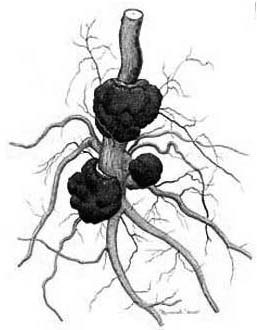Crown Gall
Tate Hancox, Adelaide.
Summarised from an assignment done for his undergraduate degree, and answers to questions.
Some rose diseases and pests
Agrobacterium tumefaciens occurs normally in soil, but can become a problem by causing tumorous growth on various plants, including the rosaceae family, some nut trees, tomatoes and grape vines; most commonly at the junction of the above-ground stem and the roots (the crown). The galls are soft and light green at first, but age to woody and dark brown. The infection enters through an open wound caused by pruning, mechanical injury, chewing insects or the emergence of lateral roots. Environmental damage caused by drying out or waterlogging may also predispose to it. If large, the gall can weaken the plant or cause plant death.
Some rambling cultivars are highly susceptible and you will find galls up the stems to great heights, including where they rub against wire. This can be seen on old specimens of susceptible cultivars grown as weeping standards.

What can be done
– for affected roses?
If the infection is small and the plant has been dug up, the gall can be cut off and the cut treated with disinfectant before soaking in Gogo Juice or similar product. The rose will need to be planted into well-prepared soil or fresh potting mix.
If the infection is moderate/medium (i.e. can be seen on a mature plant at soil level) and the rose is still producing healthy growth, the plant may be left in the ground. If the gall is at surface level it may be removed using sharp tools and the infected area treated with disinfectant before applying Gogo Juice or similar product. Fresh compost will need to be applied to help reduce the amount of the disease in the soil.
If the infection is large there will be a decline in plant health, little can be done except to propagate a new plant and dispose of the old one into the green waste bin. DO NOT COMPOST! You can propagate from the infected plant provided there are no galls up the stem.
– for affected soil?
Soil will need to be treated with compost and a green manure bio-fumigant crop such as mustard over the course of 12 months. This rests the soil from roses and helps to reduce the amount of pathogen in the soil for further reinfection. Once this has occurred new plants should be OK to be planted into the affected soil. *
– for new plantings?
Treatment of new plants with an environmentally-safe product called NOGALL or similar. This inoculates the rose with a beneficial bacterium, Rhizobium rhizogenes, that out-competes the pathogenic crown gall. Not too expensive for home use, if you have a serious problem, but mainly for commercial numbers of plants.
* Ed: the purpose of the Gogo Juice and compost for crown gall is to increase the relative amount of “good” bacteria in the soil, to compete with the gall-producer. Removing the predisposing condition (poor drainage, drying out) is also necessary.
The understocks most susceptible to crown gall are recorded as R. multiflora and “Manettii” (information from Andrew Ross).
Above – ground Galls: Another Explanation
Maureen Ross, Adelaide.
Condensed and updated from the autumn Journal of 2006.
Most easy-rooting ramblers or shrubs, and ground covers when raised up as weeping standards, can produce gall-like growth on their upper branches. This occurs without galls at the crown or on the roots, and does not seem to affect the plant’s flowering, but looks quite ugly (after the leaves have fallen). It takes a long time to develop and is usually found on older plants.
When these plants are growing at ground level they root readily from the leaf nodes along the branches. When up in the air these nodes can occasionally break into ‘aerial roots’ which lead to dark, woody, rough growths about the size of a walnut, or larger.
🌹🌹🌹🌹🌹🌹🌹
Powdery Mildew
Jane Zammit, Canowindra.
Condensed from the autumn Journal of 2006, p. 36.
Some weather patterns can bring about powdery mildew: a ‘glass of milk’ for your roses makes a difference – and they’ll love it!
Powdery mildew typically shows up during seasonal transitions, times of hot dry days followed by cooler nights with relatively high humidity. First signs are a slight ‘folding up’ of the juvenile foliage, followed by the characteristic white powder and later puckering on the foliage. Plants with adequate moisture, mulch and food are more resistant to attack than those that are stressed. Some roses are ‘milge magnets’ – I choose not to grow them! [Ed: milge was David Ruston’s term for mildew.]
Milk treatment.
- Make full cream powdered milk according to directions.
- Dilute with water (1:9 ratio).
- Spray over foliage giving complete coverage, especially the juvenile foliage – that’s where ‘milge’ first strikes.
The spray will not burn the foliage even when applied on hot mornings, in fact it seems to act as a protectant to the young foliage, and makes it more supple.
Milk is safe, natural and non-toxic. If ‘milge’ does occasionally strike in your garden, please try this approach ahead of chemicals. Repeat the application about every 10 days during problem weather conditions.
🌹🌹🌹🌹🌹🌹🌹
Other natural controls of rose problems: you can buy green lacewings on line for outbreaks of thrips and aphids, and ladybirds for control of aphids. Ladybirds need access to water (eg. from watering the garden) and both require absence of insecticides.
